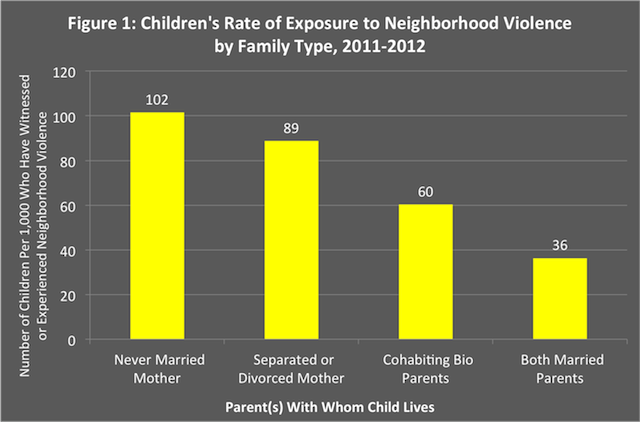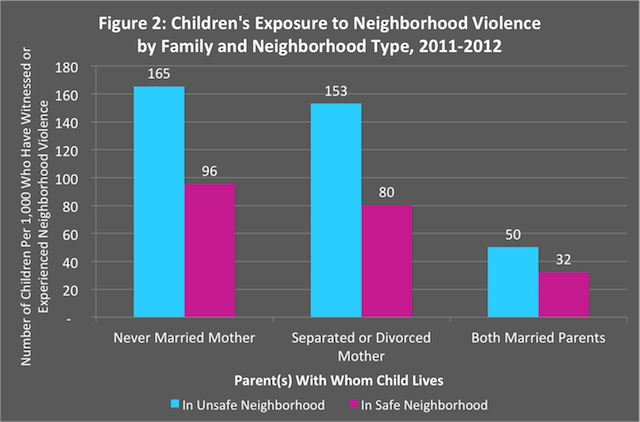Highlights
Young people are less likely to be victims of crime if they live in two-parent than in single-parent households. That has been a consistent finding of the National Crime Victimization Survey conducted by the U.S. Department of Justice. But it has been unclear whether the safety advantage stems from married couples living in less dangerous neighborhoods, on average, than unmarried parents, or from other differences in vulnerability between family types. My analysis of recent data from another national survey shows that even when their families live in unsafe neighborhoods, children in married two-parent families are less likely to be exposed to violent crime than children of never-married and divorced parents.
In the 2011-2012 National Survey of Children’s Health, conducted by the U.S. National Center for Health Statistics, parents of 95,677 children aged 17 and under were asked whether their child was “ever the victim of violence or witnessed any violence in his or her neighborhood.” Among children living with their married biological parents, the overall rate of exposure to neighborhood violence was comparatively low: for every 1,000 children in intact families, 36 had witnessed or experienced neighborhood violence. By contrast, among children living with a never-married mother, the rate of violent crime exposure was nearly three times higher: 102 children per 1,000 had one or more such experiences. Among children living with a separated or divorced mother, the rate of exposure was more than twice as high as for children of married parents: 89 children per 1,000. (See Figure 1.) These comparisons are adjusted for differences across family types in the average age, sex, and race/ethnicity of the child; family income and poverty status; the parent’s education level; neighborhood quality; and frequency of residential moves.

Some might assume that the absence of an adult male to protect the household is key to the higher victimization rates of single-parent families. Yet children living with a biological parent and a stepparent also had an elevated rate of exposure to neighborhood violence: 84 children per 1,000. Even children living with both biological parents who were cohabiting rather than married had a significantly higher victimization rate—60 children per 1,000—though not as high as those in never-married or divorced families.
Based on a series of questions to parents in the health survey, the neighborhood in which each child lived was classified as safe and supportive of families with children, or as unsafe or unsupportive.i Not surprisingly, kids living in neighborhoods that their parents perceived to be unsafe or unsupportive were more likely to have witnessed or experienced neighborhood violence than those living in safe and supportive neighborhoods, with respective victimization rates of 79 versus 46 children per 1,000. Also as expected, children living with never-married mothers were twice as likely as those in intact families to be living in unsafe or unsupportive neighborhoods: 44 percent versus 19 percent. Children living with separated or divorced mothers fell in between, with 34 percent of them residing in unsafe or unsupportive neighborhoods.
Children also had higher rates of exposure to violence if their families had moved frequently. Kids who had changed residence three or more times since their birth, for example, had nearly double the rate of exposure to neighborhood violence as those who had moved less than three times: 79 versus 43 children per 1,000 had witnessed or experienced neighborhood violence. Nearly half (47 percent) of children living with separated or divorced mothers had moved three or more times. The moves were often the result of the family breakup. But 39 percent of children living with never-married mothers had also moved that often, compared to 21 percent of children living with both married parents. However, even after adjusting for differences in frequency of family moves and neighborhood safety and supportiveness, children of unmarried mothers continued to have higher rates of exposure to neighborhood violence than children of married parents.
When I looked at combinations of neighborhood safety and family type in which children lived, those living with never-married mothers in unsafe or unsupportive neighborhoods unsurprisingly had the highest rate of encountering neighborhood violence: 165 children per 1,000. This was five times the rate of violence exposure for children living with both married parents in safe and supportive neighborhoods: 32 children per 1,000. Children living with separated or divorced mothers in unsafe neighborhoods were not far behind their peers with never-married mothers: 153 children per 1,000. While children in intact families who resided in unsafe neighborhoods had a higher risk of encountering violence than similar children in safe neighborhoods, their rate of exposure was lower than that of children of never-married or divorced mothers who lived in safe and supportive neighborhoods. (See Figure 2.)
Again, these comparisons are adjusted for differences across family types in the average age, sex, and race/ethnicity of the child; family income and poverty status; and the parent’s education level.

Why are children living with never-married or separated and divorced mothers more susceptible to neighborhood violence? Beyond the greater likelihood of having to live in unsafe neighborhoods and the more frequent moves that often come with family disruption, there are several other factors that increase vulnerability. First is the stress of conflict between parents and the strain of raising children as a lone parent in reduced financial circumstances. These can lead to a lack of vigilance and the overlooking of simple precautions, such as making sure that doors and windows are locked in houses and vehicles. Second, if they have broken up with their child’s other parent, a single parent will usually begin dating and trying to find a new partner. This process often involves being out of the house at night, sometimes leaving children with no or inadequate supervision. Third, as children become adolescents, the peers they become involved with in their less-than-ideal neighborhoods and schools are often troubled ones, who can lead them into hazardous situations and activities.
Of course, many single mothers take pains and make personal sacrifices to ensure that their offspring do not become victims of crime. And most succeed in keeping their children safe. But the survey data show that the best form of home security is a stable marriage.
i. For safe neighborhood: “How often do you feel [child name] is safe in your community or neighborhood? Would you say never, sometimes, usually, or always?” For supportive neighborhood, respondents were asked whether they strongly agree, somewhat agree, somewhat disagree, or strongly disagree with each of the following statements: “People in my neighborhood help each other out,” “We watch out for each other’s children in this neighborhood,” “There are people I can count on in this neighborhood,” and “If my child were outside playing and got hurt or scared, there are adults nearby who I trust to help my child.”













